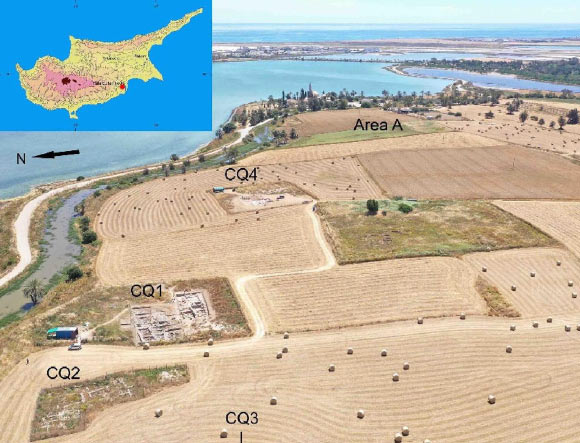Field works at Hala Sultan Tekke, Cyprus, shed light on the scope of interregional trade in which this Bronze Age harbor city participated from the 15th to the 12th centuries BCE, according to an archaeologist from the University of Gothenburg.
Hala Sultan Tekke developed in the 15th century BCE from a village to an important maritime trade hub with a minimum size of 25 hectares as indicated by the results of geophysical survey. Image credit: Peter M. Fischer, doi: 10.1016/j.jasrep.2022.103722.
The Late Bronze Age city of Hala Sultan Tekke is situated on the southeast coast of Cyprus on the shore of the Larnaca Salt Lake near the international airport of Larnaca.
Apart from a horse stable, the site is not covered by modern structures and thus ideal for archaeological research.
The position of the city on the shoreline of a Mediterranean bay, which in the Bronze Age cut deep into the island, provided an excellent sheltered harbor, and contributed to the city’s ability to establish and amplify interregional contacts.
“We have found huge quantities of imported pottery in Hala Sultan Tekke, but also luxury goods made of gold, silver, ivory and semi-precious gemstones which show that the city’s production of copper was a trading commodity in high demand,” said University of Gothenburg’s Professor Peter Fischer.
“Our investigations and excavations show that Hala Sultan Tekke was larger than was previously thought, covering an area of some 25 to 50 hectares, which is a big city by that period’s standards.”
“Usually, settlements at this time and in this area covered only a few hectares.”
“Remains in the city show extensive copper production in the form of smelting furnaces, cast moulds and slag,” he added.
“The ore from which the copper was extracted was brought into the city from mines in the nearby Troodos Mountains.”
“The workshops produced a lot of soot and were placed in the north of the city so that the winds mainly from the south would blow the soot and the stench away from the city.”
“Today, this type of production would be impossible, since the production process generates waste products such as arsenic, lead and cadmium, but at that time people did not know how dangerous the process was.”
In addition to copper, Hala Sultan Tekke also produced highly sought-after purple-dyed textiles and pottery with characteristic painted motifs of humans, animals and plants.
The researchers refer to the artist behind these painted motifs as the ‘Hala Sultan Tekke painter.’
“The great thing about the many pottery finds is that we can assist our colleagues around the Mediterranean and beyond,” Professor Fischer said.
“No pottery has the same spread as the coveted Cypriot pottery during this period.”
“By finding locally made pottery that we can date in the same layer as other imported pottery that was previously difficult to date, we can synchronize these and help colleagues date their finds.”
Professor Fischer and colleagues also unearthed a large number of imported pottery, jewelry and other luxury goods from neighboring regions such as modern-day Greece, Türkiye, the Middle East and Egypt, as well as longer-distance imports from Sardinia, the Baltic Sea region, Afghanistan and India.
The finds show that the city was one of the largest trade hubs in the period 1500-1150 BCE and was of great importance during the initial period of international trade in the area.
Trade flourished in the city for almost 500 years, but like several other sophisticated Bronze Age civilizations around the Mediterranean, Hala Sultan Tekke collapsed just after 1200 BCE.
The prevailing hypothesis was that the Sea Peoples invaded the eastern Mediterranean around this time, destroying its cities and bringing the Bronze Age civilizations to an end.
“In the past, it was thought that the Sea Peoples were the sole explanation. Our research in recent years has given more nuance to this explanation,” Professor Fischer said.
“For example, there are now new interpretations of written sources from this period in Anatolia (modern-day Türkiye), Syria and Egypt, which tell of epidemics, famine, revolutions and acts of war by invading peoples.”
“In addition, our investigations indicate that a deterioration in the climate was a contributing factor.”
“All of this may have had a domino effect, that people in search of better living conditions moved from the central Mediterranean towards the south-east, thus coming into conflict with the cultures in modern-day Greece, on Cyprus and in Egypt.”
The findings appear in the Journal of Archaeological Science: Reports.
_____
Peter M. Fischer. 2023. Interregional trade at Hala Sultan Tekke, Cyprus: Analysis and chronology of imports. Journal of Archaeological Science: Reports 47: 103722; doi: 10.1016/j.jasrep.2022.103722




